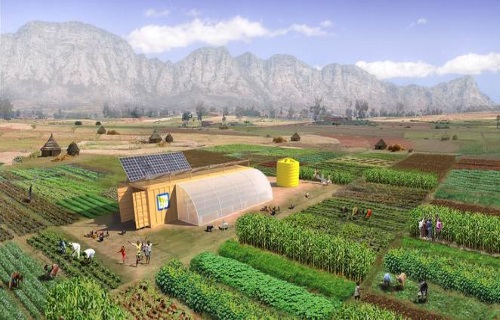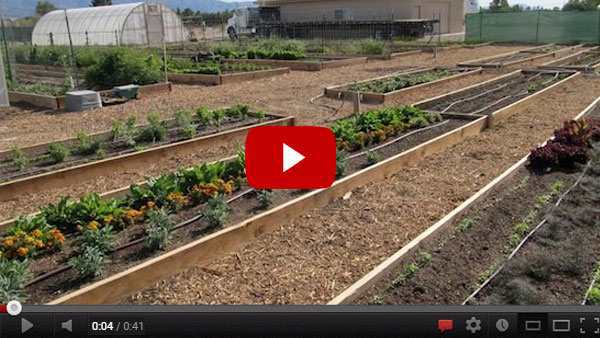
The Farm From A Box system is designed to feed 150 people per year, and includes drip irrigation, all of the tools, and its own renewable energy setup.
How are we going to feed 9 billion people by 2050? The answer to this question — or the lack thereof — is one of the biggest issues in agriculture today. Experts estimate that we need to grow 60 percent more food than we currently produce. And as a result, there is a push to constantly create more. More miracle crops. More monocultures. More monocrops. More seeds. More food.
As urban populations continue to rise, innovators are looking beyond traditional farming as a way to feed everyone while having less impact on our land and water resources.
Using regenerative agriculture techniques with precision farming technology, we have developed the most efficient and easy mechanism for starting and maintaining an off-grid 2-acre farm. Healthy food, locally grown.
A local food system makes a lot of sense to me, because the money stays in that community and we can create thousands of jobs. We are losing rural farmland and rural farmers. So what we need to do is not only grow soil, but grow farmers, train farmers to be able to farm a different kind of way. Not like our fathers and grandfathers farmed, but this new kind of farming where you are thinking about square footage and growing in unusual places inside the city inside buildings and on rooftops.
What’s driven me is to be a part of ending world hunger. The United Nations stated in 2010 that the only way to end world hunger is through local food systems. It benefits everybody to have a local food system. My energy and the energy at Growing Power goes into creating and quantifying these things because people don’t believe that you can grow a significant amount of food inside a city. It is not the total answer. It’s going to take a renaissance of farmers as well as urban farmers to develop this sustainable food system.
Several observations about the Great Depression
Both the Great Depression hit as well as a Great Drought. The combination meant huge agricultural losses in the bread basket states like Nebraska. That lead to high livestock feed prices and therefore an inability to feed animals. Add in an inability to water animals and you had premature deaths and many livestock harvested prematurely. We could see all of that and much of that is happening.
Soils became sterile as the humus (living layers of decay and bacteria) became airbourne. Those take huge amounts of time to occur over large regions unless the weather changes and special agricultural techniques are used. That soil resulted in Valley Fever, a transmission of the soil and bacteria and fungus into the lungs of the local inhabitants. Expect more cases of this.
In fertile areas, because of the fall in the price of the produce grown, it sometimes was simply wasted instead of being shipped due to the lack of profit.
Many tenant farmers lost their historical homes and livelihood. They were in essence forced to “bug out” in search of places to live and employment. Many became migrant workers and went out West, but many were turned away by vagrancy laws. We could see more and more homelessness, more tent cities, folks living in ramshackle thrown together survival shelters, but without any hope of employment.
Railroads facilitated the movement of unemployed young men to the West. That option is largely out today by railroad bulls limiting “hoppin’ a freight”. Many such young unemployed men ended up working for the Civilian Conservation Corps (CCC). They performed mostly untrained labor for a steady rate and received room and board, often in tent cities. Many of the state parks in your region were likely built and maintained by them during that time period. Lots of bridges and road projects were also done. Because something like 90% of US roadways and bridges are architecturally unsound, it is highly likely with the historical precedents of such things that some insane officials might decide to reenact such ideas of labor camps.
Many men once losing their livelihood elected to abandon their families as they had no prospect of supporting them. I would certainly expect to see more and more of that. Expect for increasing amounts of homeless children with no parental guidance. That tends to increase vice in cities as their only ways of supporting themselves are horrendous ones.
Food was significantly different under the Great Depression. One might eat a lard sandwich which is precisely as described. Corn pone was a common meal. The rich diverse meals that we possess today might completely change and with far less regularity. One might work for a meal instead of pay.
Many wealthy folks bought up stocks for pennies on the dollar…in effect a planned implosion to consolidate wealth. Prior to the Great Depression, many investors had no business speculating in the stock market and largely bought on credit (margin). They lost everything.
Despite many public work programs, the only significant change in the economy was when the US sold munitions to Britain to fight WW2 against the Nazis. Then when the USA entered the war, it put huge numbers of unemployed men back to work in the military, and since they weren’t running the factories, created the modern concept of women working in factories as “Rosie the Riveter”. That’s why things picked up and we can expect the lure of that to infect politicians once again.
Going off-grid has a myriad of challenges, and this can be compounded for those who are looking to do so in a larger scale such as an entire community. Aside from providing power, water, sewage and the other basic services many are accustomed to, there is also the issue of being able to grow enough food to be able to provide for everyone or at least make a big enough dent to reduce the need for any outside assistance.
“Based on extensive field research, we found that rural communities often lack the resources and infrastructure needed to access nutritious food. We developed a toolkit that contains all of the core components needed to grow your own food, on a two acre plot of land, without the need for an existing grid. Imagine the good it can do by growing local, organic food for a school, or helping jumpstart food production after a disaster. ‘Farm from a Box’ enables and empowers communities to provide for themselves.” – DeCarli
That can be used to build a stronger local food system, especially in food deserts and in the developing world, where infrastructure can be spotty and unreliable at best, and possibly even non-existent. The system is described as being “food sovereignty in a box” that can be a “Swiss Army Knife” for off-grid farming, and while there is a basic template, each unit can be customized to fit the particular situation.
Farm From a Box is a kit designed to make it easier for all types of organizations to start growing sustainable food. Nonprofit humanitarian agencies, schools, community groups, and even individuals can buy a $50,000 kit, which comes with a complete water system including a solar-powered pump and drip irrigation system. Together, those features help conserve water by using it more efficiently, delivering water directly to the roots of growing plants. All of the kit’s components are solar-powered, so the kit also includes 3 kW of solar energy capacity which is enough to power the water pump as well as WiFi connectivity that makes it possible to monitor the farm conditions remotely. Because the built-in solar power technology generates more than enough energy to power the farm’s equipment, the farm is suitable to run completely off the grid.
“MY SURVIVAL FARM”
…and it’s like nothing you’ve ever seen before… An A to Z guide on survival gardening that is easy to read and a joy to put into practice, full of photos, diagrams and step by step advice. Even a kid can do this and, in fact, I encourage you to let the little ones handle it, to teach them not just about self-reliance but also about how Mother Nature works.
Here is just a glimpse of what you’ll find inside:
How to plan, design and put into action high-yield survival garden that will literally keep you and your family fed for life, no matter what hits you, even when everyone else around you is starving to death. No digging and planting year after year and no daily watering because you’ll have more important things to worry about when TSHTF.
How to set up highly nutritious soil for your plants. Do this before you plant anything and you’re on your way to setting your food forest on auto-pilot for decades to come. I’m gonna tell you this one “weird” thing to add to the mulch that’s not only highly effective but also 100% free (because you already have it in your home right now).
Step-by-step instructions on how to plant over 125 plants inside your permaculture garden. Plus, special instructions on choosing the right ones for your climate. From Arizona to Alaska, you can do this anywhere…
How to “marry” your plants. We’re gonna tell you which grow well together and help each-other survive and thrive, so they don’t ever compete for sunlight and nutrients. You get the full table of plants that work well with one another as well as the ones you should NEVER be put together. (Source)
Our grandfathers had more knowledge than any of us today and thrived even when modern conveniences were not available. They were able to produce and store their food for long periods of time. The Lost Ways is the most comprehensive book available. All the knowledge our grandfathers had, in one place.Here’s just a glimpse of what you’ll find in the book:
Table Of Contents:
Making Your Own Beverages: Beer to Stronger Stuff
Ginger Beer: Making Soda the Old Fashioned Way
How North American Indians and Early Pioneers Made Pemmican
Wild West Guns for SHTF and a Guide to Rolling Your Own Ammo
How Our Forefathers Built Their Sawmills, Grain Mills,and Stamping Mills
How Our Ancestors Made Herbal Poultice to Heal Their Wounds
What Our Ancestors Were Foraging For? or How to Wildcraft Your Table
How North California Native Americans Built Their Semi-subterranean Roundhouses
Our Ancestors’Guide to Root Cellars
Good Old Fashioned Cooking on an Open Flame
Learning from Our Ancestors How to Preserve Water
Learning from Our Ancestors How to Take Care of Our Hygiene When There Isn’t Anything to Buy
How and Why I Prefer to Make Soap with Modern Ingredients
Temporarily Installing a Wood-Burning Stove during Emergencies
Making Traditional and Survival Bark Bread…….
Trapping in Winter for Beaver and Muskrat Just like Our Forefathers Did
How to Make a Smokehouse and Smoke Fish
Survival Lessons From The Donner Party
Get your paperback copy HERE
Here’s just a glimpse of what you’ll find in The Lost Ways:
From Ruff Simons, an old west history expert and former deputy, you’ll learn the techniques and methods used by the wise sheriffs from the frontiers to defend an entire village despite being outnumbered and outgunned by gangs of robbers and bandits, and how you can use their wisdom to defend your home against looters when you’ll be surrounded.
Native American ERIK BAINBRIDGE – who took part in the reconstruction of the native village of Kule Loklo in California, will show you how Native Americans build the subterranean roundhouse, an underground house that today will serve you as a storm shelter, a perfectly camouflaged hideout, or a bunker. It can easily shelter three to four families, so how will you feel if, when all hell breaks loose, you’ll be able to call all your loved ones and offer them guidance and shelter? Besides that, the subterranean roundhouse makes an awesome root cellar where you can keep all your food and water reserves year-round.
From Shannon Azares you’ll learn how sailors from the XVII century preserved water in their ships for months on end, even years and how you can use this method to preserve clean water for your family cost-free.
Mike Searson – who is a Firearm and Old West history expert – will show you what to do when there is no more ammo to be had, how people who wandered the West managed to hunt eight deer with six bullets, and why their supply of ammo never ran out. Remember the panic buying in the first half of 2013? That was nothing compared to what’s going to precede the collapse.
From Susan Morrow, an ex-science teacher and chemist, you’ll master “The Art of Poultice.” She says, “If you really explore the ingredients from which our forefathers made poultices, you’ll be totally surprised by the similarities with modern medicines.” Well…how would you feel in a crisis to be the only one from the group knowledgeable about this lost skill? When there are no more antibiotics, people will turn to you to save their ill children’s lives.
If you liked our video tutorial on how to make Pemmican, then you’ll love this: I will show you how to make another superfood that our troops were using in the Independence war, and even George Washington ate on several occasions. This food never goes bad. And I’m not talking about honey or vinegar. I’m talking about real food! The awesome part is that you can make this food in just 10 minutes and I’m pretty sure that you already have the ingredients in your house right now.
Really, this is all just a peek.
The Lost Ways is a far–reaching book with chapters ranging from simple things like making tasty bark-bread-like people did when there was no food-to building a traditional backyard smokehouse… and many, many, many more!
Books can be your best pre-collapse investment.
The Lost Ways (Learn the long forgotten secrets that helped our forefathers survive famines,wars,economic crisis and anything else life threw at them)
Survival MD (Best Post Collapse First Aid Survival Guide Ever)
Conquering the coming collapse (Financial advice and preparedness )
Liberty Generator (Build and make your own energy source)
Backyard Liberty (Easy and cheap DIY Aquaponic system to grow your organic and living food bank)
Bullet Proof Home (A Prepper’s Guide in Safeguarding a Home )
Family Self Defense (Best Self Defense Strategies For You And Your Family)
Survive Any Crisis (Best Items To Hoard For A Long Term Crisis)
Survive The End Days (Biggest Cover Up Of Our President)




I have come up with an idea to recycle the Depleted Oil &Natural Gas Well Locations and transform them into Renewable Energy Powered Greenhouses. The Costs would be offset by selling Solar Electricity to the Grid. My idea involves using the heat from the Well Boreal_Centre to heat Aquaponic Systems that would be housed in converted SeaCans. I would like to learn more about your Systems and possibly exchange some ideas and thoughts with you. I’m not trying this to make money but instead to get the Hundreds of Thousands of Contaminated Sites cleaned up without it being a burden on the citizens of my home province Alberta, Canada.